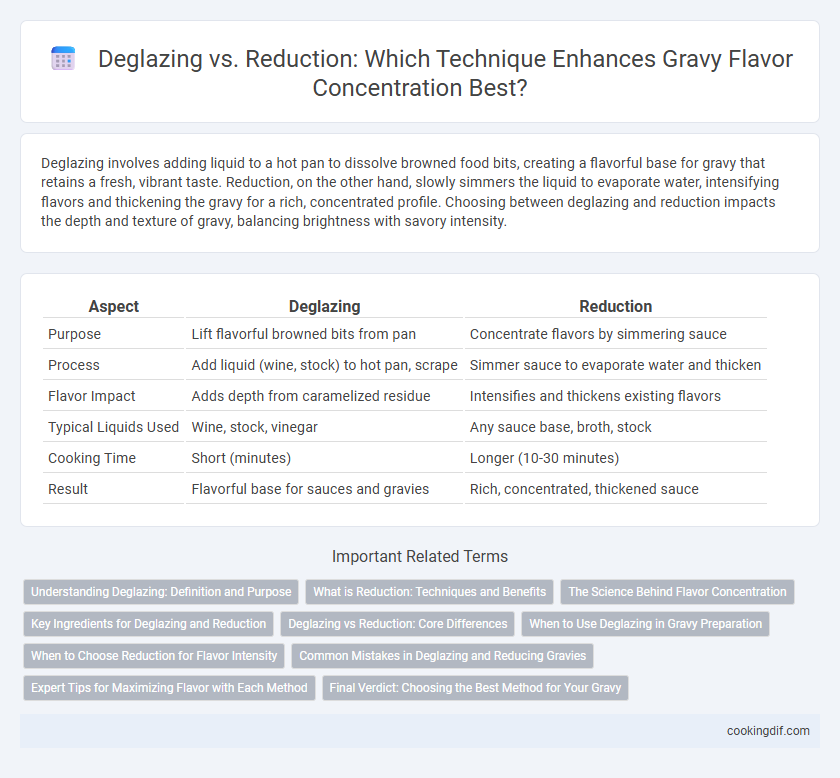Deglazing involves adding liquid to a hot pan to dissolve browned food bits, creating a flavorful base for gravy that retains a fresh, vibrant taste. Reduction, on the other hand, slowly simmers the liquid to evaporate water, intensifying flavors and thickening the gravy for a rich, concentrated profile. Choosing between deglazing and reduction impacts the depth and texture of gravy, balancing brightness with savory intensity.
Table of Comparison
| Aspect | Deglazing | Reduction |
|---|---|---|
| Purpose | Lift flavorful browned bits from pan | Concentrate flavors by simmering sauce |
| Process | Add liquid (wine, stock) to hot pan, scrape | Simmer sauce to evaporate water and thicken |
| Flavor Impact | Adds depth from caramelized residue | Intensifies and thickens existing flavors |
| Typical Liquids Used | Wine, stock, vinegar | Any sauce base, broth, stock |
| Cooking Time | Short (minutes) | Longer (10-30 minutes) |
| Result | Flavorful base for sauces and gravies | Rich, concentrated, thickened sauce |
Understanding Deglazing: Definition and Purpose
Deglazing is a cooking technique involving adding liquid such as wine, broth, or vinegar to a hot pan to dissolve browned food residues known as fond, enhancing the depth and complexity of gravy flavors. This process extracts concentrated flavors by loosening caramelized bits stuck to the pan after sauteing or roasting, boosting the richness of the sauce. Understanding deglazing is essential for achieving a balanced umami profile and improved taste intensity in gravies.
What is Reduction: Techniques and Benefits
Reduction is a cooking technique that intensifies flavor by simmering liquids such as stock, wine, or vinegar to evaporate water, concentrating the taste and thickening the consistency. This process enhances gravies by deepening the savory notes and creating a richer texture without adding extra ingredients. Mastering reduction allows chefs to control the balance of flavors and achieve a more robust, velvety finish in their sauces.
The Science Behind Flavor Concentration
Deglazing involves adding liquid to a hot pan to dissolve browned food particles, releasing intense umami-rich compounds that enhance gravy's depth. Reduction concentrates flavors by simmering liquids, evaporating water and intensifying taste and texture through the Maillard reaction products retained during cooking. Understanding these processes allows chefs to maximize savory complexity and achieve a balanced, richly flavored gravy.
Key Ingredients for Deglazing and Reduction
Deglazing involves adding a liquid such as wine, broth, or vinegar to a hot pan to dissolve browned bits, enhancing flavor complexity with acidity and moisture. Reduction concentrates flavors by simmering liquids like stock, cream, or wine, evaporating water to intensify taste and thicken consistency. Key ingredients for deglazing include robust liquids that complement the main dish, while reduction relies on flavorful stocks or sauces to build depth and richness.
Deglazing vs Reduction: Core Differences
Deglazing involves adding liquid such as wine or stock to a hot pan to dissolve browned food particles, creating a flavorful base for gravy, while reduction focuses on simmering a liquid to evaporate water and concentrate flavors. Deglazing enhances the umami profile by capturing fond from cooked meats, whereas reduction intensifies the overall taste by thickening the sauce through evaporation. Understanding these core differences is essential for mastering flavor concentration in gravy preparation.
When to Use Deglazing in Gravy Preparation
Deglazing is essential in gravy preparation when lifting fond, the caramelized bits at the bottom of the pan, to infuse deep, savory flavors into the sauce. It is best used immediately after sauteing or roasting meats before adding liquids, as the hot pan releases concentrated umami compounds. This method ensures a rich flavor base by dissolving browned residues with wine, stock, or vinegar, enhancing the gravy's complexity.
When to Choose Reduction for Flavor Intensity
Reduction is ideal for achieving intense, concentrated gravy flavors by simmering liquids to evaporate water and deepen taste. This method is preferred when a rich, thick texture is desired, such as with beef or veal gravies. Deglazing extracts browned bits from the pan but offers a lighter flavor concentration compared to reduction.
Common Mistakes in Deglazing and Reducing Gravies
Deglazing often involves pouring liquid into a hot pan to dissolve browned bits, but common mistakes include adding cold liquid that causes steaming instead of scraping, and using too much liquid that prevents proper flavor concentration. Reduction, crucial for thickening and intensifying gravy, is frequently rushed or done at too high heat, resulting in burnt flavors or uneven consistency. Careful temperature control and gradual liquid addition optimize the balance between deglazing and reducing for rich, flavorful gravy.
Expert Tips for Maximizing Flavor with Each Method
Deglazing involves adding liquid to a hot pan to dissolve browned bits, intensifying a gravy's savory depth, while reduction slowly simmers the liquid to concentrate flavors and thicken texture. Expert tips for deglazing include using wine, stock, or vinegar to enhance complexity and ensuring the pan is hot enough to release fond efficiently. For reduction, maintain a low simmer and avoid rushing the process to prevent bitterness and achieve a rich, balanced gravy.
Final Verdict: Choosing the Best Method for Your Gravy
Deglazing unlocks rich, complex flavors by dissolving browned bits from the pan, creating a deeply savory base for gravy. Reduction intensifies the gravy's taste by simmering liquids to concentrate flavors and thicken texture without added ingredients. For the best gravy, combine deglazing to capture robust flavors with reduction to achieve desired consistency and depth.
Deglazing vs Reduction for flavor concentration Infographic

 cookingdif.com
cookingdif.com